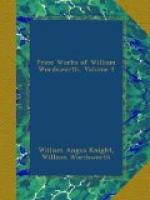[52] In fact there is not an instance of a harbour on the Cumberland side of the Solway frith that is not dry at low water; that of Ravenglass, at the mouth of the Esk, as a natural harbour is much the best. The Sea appears to have been retiring slowly for ages from this coast. From Whitehaven to St. Bees extends a tract of level ground, about five miles in length, which formerly must have been under salt water, so as to have made an island of the high ground that stretches between it and the Sea.
The WOODS consist chiefly of oak, ash, and birch, and here and there Wych-elm, with underwood of hazel, the white and black thorn, and hollies; in moist places alders and willows abound; and yews among the rocks. Formerly the whole country must have been covered with wood to a great height up the mountains; where native Scotch firs[53] must have grown in great profusion, as they do in the northern part of Scotland to this day. But not one of these old inhabitants has existed, perhaps, for some hundreds of years; the beautiful traces, however, of the universal sylvan[54] appearance the country formerly had, yet survive in the native coppice-woods that have been protected by inclosures, and also in the forest-trees and hollies, which, though disappearing fast, are yet scattered both over the inclosed and uninclosed parts of the mountains. The same is expressed by the beauty and intricacy with which the fields and coppice woods are often intermingled: the plough of the first settlers having followed naturally the veins of richer, dryer, or less stony soil; and thus it has shaped out an intermixture of wood and lawn, with a grace and wildness which it would have been impossible for




